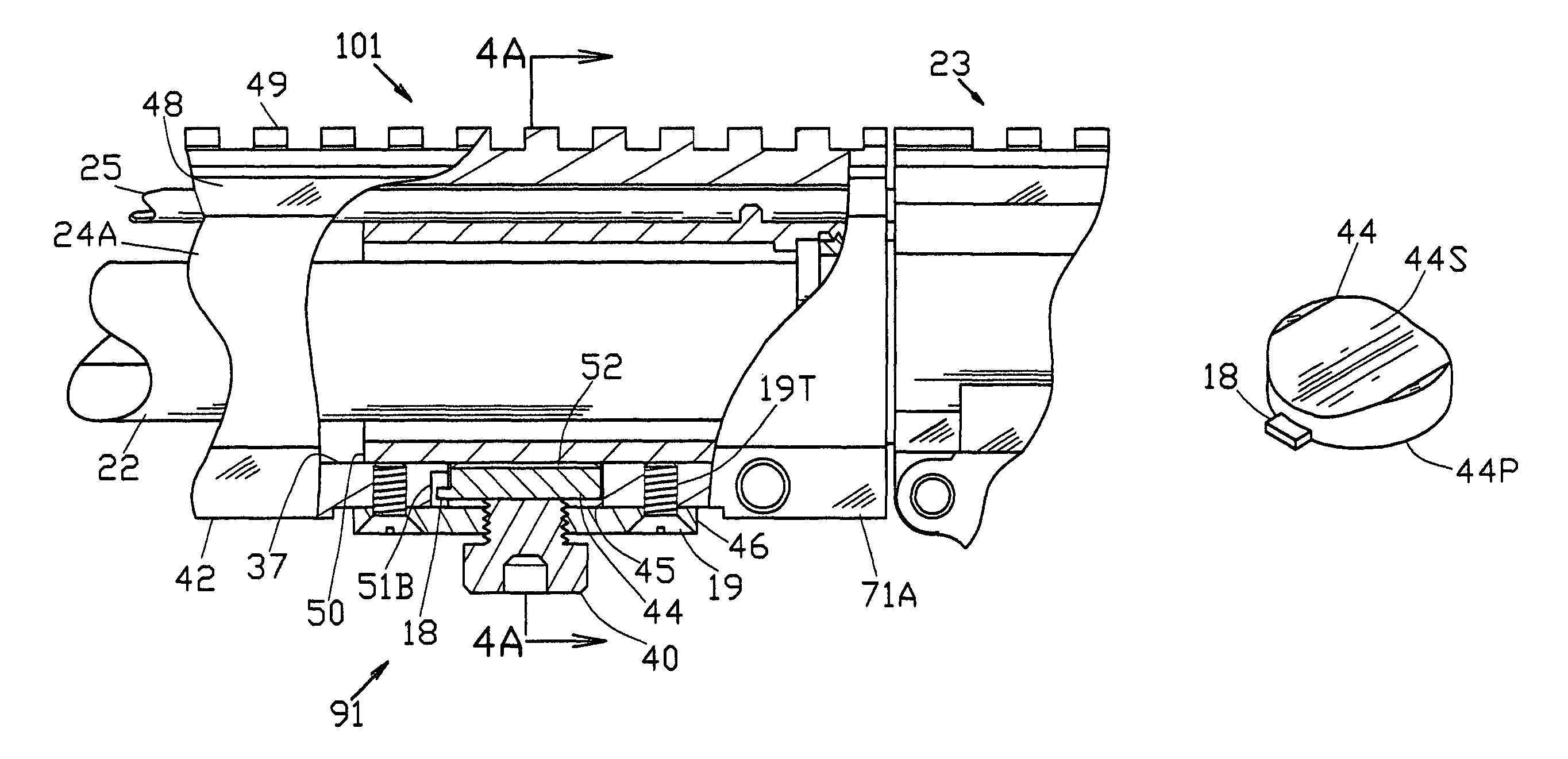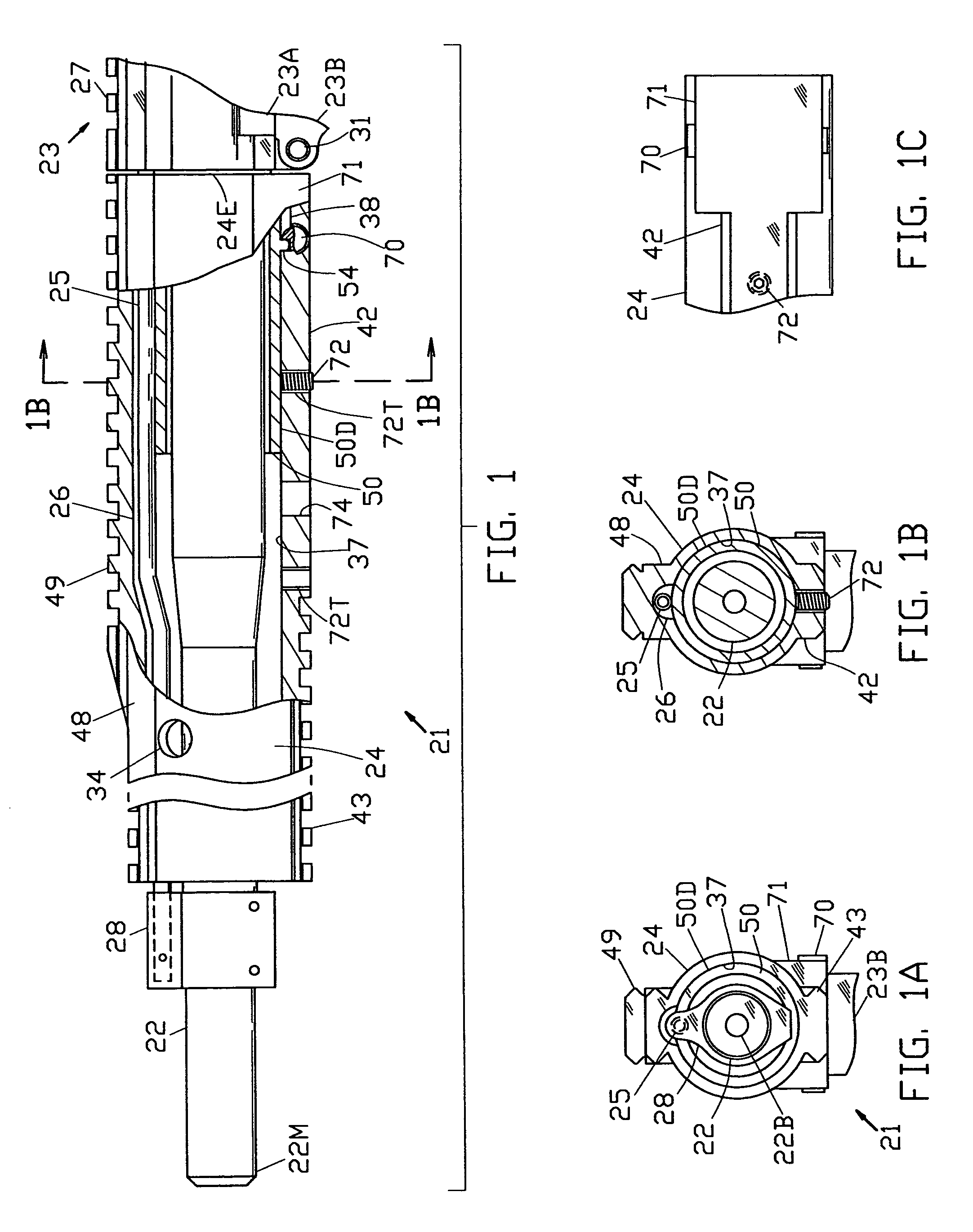Handguard system with clamp device
a technology of clamping device and handguard, which is applied in the field of handguards, can solve the problems of temporary disablement of weapons, adversely affecting accuracy, impracticality or impossible, etc., and achieve the effect of preventing handguard misalignmen
- Summary
- Abstract
- Description
- Claims
- Application Information
AI Technical Summary
Benefits of technology
Problems solved by technology
Method used
Image
Examples
first embodiment
[0283]In operation, considering system embodiment 101 in FIGS. 4-4A, handguard 24A is shown engaging barrel nut 50, but clamp device 91 is in the unclamped position.
[0284]To secure handguard 24A to nut 50, actuating screw 40 is tightened and advanced in the direction of arrow A, screw end 40E contacting and moving pad 44. Gap 52 which, as an example, may measure 0.030 inch unclamped, is reduced to zero during the tightening of screw 40. After tightening of screw 40, barrel nut 50 is firmly gripped between pad 44 and the opposing or upper part of handguard inner diameter 37 which is in contact with nut outside diameter 50D.
[0285]To ensure that nut 50 is firmly gripped, for this embodiment, screw head 40H does not contact plate 46 in the tightened position, not shown. For this simple, single stage clamping process, proper tightening, or applied torque, is user-controlled by either a torque wrench, or more often in practice, by operator “feel”. For this embodiment, the purpose of head ...
second embodiment
[0296]For system embodiment 102, the clamping process is significantly different, as described below, than that for embodiment 101. Shown in FIGS. 6-6A, handguard 24B with clamp device 92 are installed to barrel nut 50 and device 92 is in the unclamped position with gap 52 separating pad 44A from nut diameter 50D. Spring 47 is in an unloaded or free position.
[0297]To secure handguard 246 to nut 50, actuating screw 40A is advanced in the direction of arrow B and tightened. Unlike embodiment 101, this clamping process is a two-stage process. First, tightening and advancing screw 40A elevates both pad 44A and spring 47 until pad surface 44S contacts nut diameter 50D. Consequently, gap 52 which, as an example, may measure 0.030 inch unclamped, is reduced to zero, as seen in FIG. 6B.
[0298]In the second stage of clamping, continued advance of screw 40A begins to compress and load spring 47 which transmits its force to pad 44A. Unlike embodiment 101, force applied to pad 44A, during clampi...
third embodiment
[0303]FIG. 6F shows a slightly different embodiment of clamp device 92, designated as clamp device 93. Device 93 is shown in the unclamped position. Clamp device 93 is similar to device 92 but includes an actuating screw 40B. Screw 40B includes a larger head 61D, which has a locking helicoil insert 61H for receiving an adjustment screw 61. The axis of insert 61H is parallel to the axis of actuating screw 40B. Screw 61 can be adjusted in the directions shown by arrow S to protrude from head 61D as desired.
[0304]When actuating screw 40B is tightened in the direction of arrow C, as when securing handguard 24B to barrel nut 50, adjustment screw 61, depending on its adjustment, contacts plate 46, thus limiting the travel of actuating screw 40B, thus limiting the deflection and force applied by spring 47 to pad 44A. Locking helicoil insert 61H locks adjustment screw 61 at the desired setting. Consequently, the gripping force that clamp device 93 applies to barrel nut 50 can controlled by ...
PUM
 Login to View More
Login to View More Abstract
Description
Claims
Application Information
 Login to View More
Login to View More - R&D
- Intellectual Property
- Life Sciences
- Materials
- Tech Scout
- Unparalleled Data Quality
- Higher Quality Content
- 60% Fewer Hallucinations
Browse by: Latest US Patents, China's latest patents, Technical Efficacy Thesaurus, Application Domain, Technology Topic, Popular Technical Reports.
© 2025 PatSnap. All rights reserved.Legal|Privacy policy|Modern Slavery Act Transparency Statement|Sitemap|About US| Contact US: help@patsnap.com



